
The Kansas Turnpike is a 236-mile (380 km) controlled-access toll road that lies entirely within the US state of Kansas. It runs in a general southwest–northeast direction from the Oklahoma border to Kansas City. It passes through several major Kansas cities, including Wichita, Topeka, and Lawrence. The turnpike is owned and maintained by the Kansas Turnpike Authority (KTA), which is headquartered in Wichita.
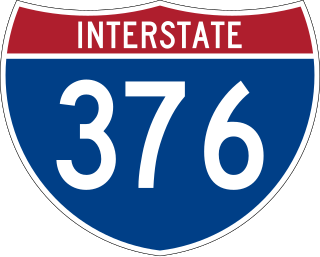
Interstate 376 (I-376) is a major auxiliary route of the Interstate Highway System in the US state of Pennsylvania, located within the Allegheny Plateau. It runs from I-80 near Sharon south and east to a junction with the Pennsylvania Turnpike in Monroeville, after having crossed the Pennsylvania Turnpike at an interchange in Big Beaver. The route serves Pittsburgh and its surrounding areas and is the main access road to Pittsburgh International Airport (PIT). Portions of the route are known as the Beaver Valley Expressway, Southern Expressway, and Airport Parkway. Within Allegheny County, the route runs along the majority of the Penn-Lincoln Parkway, known locally as Parkway West and Parkway East. It is currently the ninth-longest auxiliary Interstate route in the system and second only to I-476 within Pennsylvania.

The John Kilpatrick Turnpike is a controlled-access toll road in Oklahoma City, Oklahoma. The turnpike forms a partial beltway that runs from State Highway 152 (SH-152) to an interchange with Interstate 35 (I-35) and I-44. At the eastern terminus, traffic continuing east merges with I-44 traffic, forming the Turner Turnpike. The Kilpatrick Turnpike is 29.4 miles (47.3 km) long.
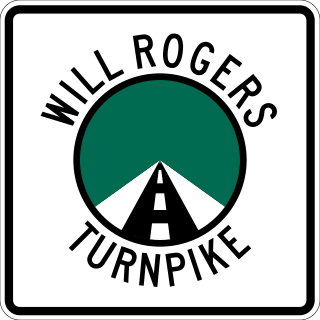
The Will Rogers Turnpike is a controlled-access toll road in the northeast portion of the U.S. state of Oklahoma. The highway begins as a continuation of the Creek Turnpike in Tulsa, continuing northward from the I-44/US-412 interchange there to the Missouri state line west of Joplin, Missouri. The turnpike carries the I-44 designation for its entire length. The turnpike is 88.5 miles (142.4 km) long and costs $4.75 to drive one way. The Will Rogers Turnpike opened to traffic on June 28, 1957. It was designated as I-44 in 1958. It is named for Will Rogers, "Oklahoma's Favorite Son".

The Cimarron Turnpike is a controlled-access toll road in north-central Oklahoma. The route travels 67 miles (108 km), from an interchange with Interstate 35 (I-35) north of Perry, to Westport, just west of Tulsa. The route also consists of a 7.2-mile (11.6 km) spur which runs from the mainline southwest to an interchange with U.S. Route 177 (US-177) north of Stillwater.

Interstate 283 (I-283) is an auxiliary route of the Interstate Highway System located just east of Harrisburg, Pennsylvania. It travels from the Harrisburg East interchange of I-76 north to I-83/U.S. Route 322 at the Eisenhower Interchange. Pennsylvania Route 283 continues southeast from near the southern terminus of I-283 to Lancaster as a freeway, functioning as an extension of the Interstate, though they are two separate roads.

State Highway 66 is a 192.7-mile (310.1 km) state highway in the U.S. state of Oklahoma, beginning at U.S. Highway 81 in El Reno and ending at U.S. Highway 60 near White Oak. The highway was designated in 1985 as a replacement for the decommissioned U.S. Highway 66. Although most of the highway follows Historic Route 66, the highway follows US 66's final alignment, joining Interstate 44 through Tulsa and Oklahoma City, while older versions of the route follow various city streets through both cities.

The Wendell H. Ford Western Kentucky Parkway is a 98.5-mile (158.5 km) freeway running from Elizabethtown, Kentucky to near Nortonville, Kentucky. It intersects with Interstate 65 (I-65) at its eastern terminus, and I-69 at its western terminus. It is one of seven highways that are part of the Kentucky parkway system. The road was renamed for Wendell H. Ford, a former Kentucky governor and United States senator, in 1998. Previously, it was simply the Western Kentucky Parkway, and often called the "WK Parkway" or "the WK" because of the acronym once used on its signs. The parkway carries the unsigned designation Kentucky Route 9001 for its entire length.
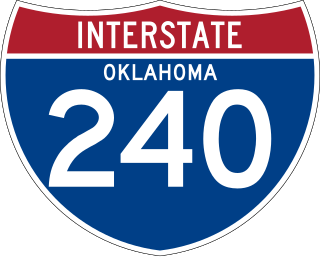
Interstate 240 (I-240) is an Interstate Highway in Oklahoma, United States, that runs 16.22 miles (26.10 km) west from I-40 to I-44 in southern Oklahoma City. After its terminus in southwest Oklahoma City, the main I-240 roadbed becomes I-44 and Airport Road toward Will Rogers World Airport. The Interstate overlaps State Highway 3 (SH-3), the longest Oklahoma state highway, for its entire length.

The Cherokee Turnpike is a controlled-access toll road in eastern Oklahoma. Opened in 1991, the route is a four-lane freeway carrying US-412 from east of Kansas, Oklahoma to east of Chouteau, and has a total length of 32.8 miles (52.8 km) and a speed limit of 80 mph (130 km/h). An alternate route, US-412 Alternate, provides a free but not controlled-access route through the towns bypassed by the Turnpike with only a 55 mph (89 km/h) speed limit.

Interstate 78 (I-78) is an east–west route stretching from Union Township, Lebanon County, Pennsylvania, to New York City. In New Jersey, I-78 is called the Phillipsburg–Newark Expressway and the Newark Bay–Hudson County Extension of the New Jersey Turnpike. The highway runs for 67.83 miles (109.16 km) in the northern part of the state of New Jersey from the I-78 Toll Bridge over the Delaware River at the Pennsylvania state line in Phillipsburg, Warren County, east to the Holland Tunnel under the Hudson River at the New York state line in Jersey City, Hudson County. The Phillipsburg–Newark Expressway portion of I-78, formally called the Lightning Division Memorial Highway, runs from the Phillipsburg area east across rural areas of western New Jersey before entering suburban areas in Somerset County. The road crosses the Watchung Mountains, widening into a local–express lane configuration at Route 24 as it continues through urban areas to Newark. Here, I-78 intersects the mainline of the New Jersey Turnpike (I-95) and becomes the Newark Bay Extension, crossing the Newark Bay Bridge and continuing to Jersey City. The route, along with Route 139, follows a one-way pair of surface streets to the Holland Tunnel.
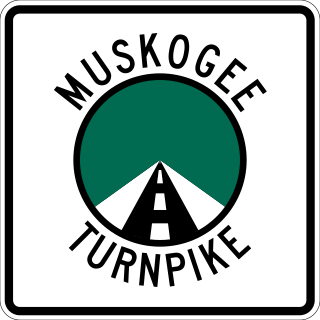
The Muskogee Turnpike, also designated State Highway 351 (SH-351), is a controlled-access toll road in eastern Oklahoma.

The Indian Nation Turnpike, also designated State Highway 375 (SH-375), is a controlled-access toll road in southeastern Oklahoma, United States, running between Hugo and Henryetta, a distance of 105.2 miles (169.3 km). It is the longest tollway in the state.

The H. E. Bailey Turnpike is an 86.4-mile (139.0 km) controlled-access toll road in the southwestern region of the U.S. state of Oklahoma. The route, opened on April 23, 1964, is a four-lane freeway that connects Oklahoma City to Lawton in its northern section and Lawton to Wichita Falls along its southern section, roughly paralleling U.S. Route 277. The turnpike also includes an 8.2-mile (13.2 km) spur route that leads toward Norman, Oklahoma. Since 1982, it has been signed as a part of Interstate 44, and as such uses its mileposts. Travel along the full length of the toll road costs $5.50 for a two-axle vehicle.

The Chickasaw Turnpike, also designated State Highway 301 (SH-301), is a controlled-access toll road in the rural south central region of the U.S. state of Oklahoma. A two-lane freeway, it stretches for 13.3 miles (21.4 km) from north of Sulphur to just south of Ada. The Oklahoma Turnpike Authority (OTA) owns, maintains, and collects tolls on the turnpike. The first section of the Chickasaw Turnpike opened on September 1, 1991.

The Creek Turnpike, also designated State Highway 364 (SH-364), is a 33.2-mile (53.4 km) controlled-access toll road that lies entirely in the U.S. state of Oklahoma. The turnpike forms a partial beltway around the south and east sides of Tulsa, Oklahoma's second largest city. The Creek Turnpike's western terminus is at the Turner Turnpike in Sapulpa, while its northeastern terminus is at the Will Rogers Turnpike in Fair Oaks; both ends of the Creek Turnpike connect with Interstate 44 (I-44). Along the way, the highway passes through the cities of Sapulpa, Jenks, Tulsa, and Broken Arrow, and the counties of Creek, Tulsa, Wagoner and Rogers. The road is maintained by the Oklahoma Turnpike Authority (OTA), except for a brief free section shared with U.S. Route 64 (US-64) and US-169. This free section is maintained by the Oklahoma Department of Transportation (ODOT).

Interstate 44 (I-44) is an Interstate Highway that runs diagonally through the U.S. state of Oklahoma, spanning from the Texas state line near Wichita Falls, Texas, to the Missouri border near Joplin, Missouri. It connects three of Oklahoma's largest cities: Oklahoma City, Tulsa, and Lawton. Most of I-44 in Oklahoma is a toll road. In southwestern Oklahoma, I-44 is the H. E. Bailey Turnpike and follows a diagonally northwest–southeast direction. From Oklahoma City to Tulsa, I-44 follows the Turner Turnpike. As I-44 leaves Tulsa, it becomes the Will Rogers Turnpike to the Missouri border. In the Lawton, Oklahoma City, and Tulsa metropolitan areas, I-44 is toll-free. In Oklahoma City, I-44 is also known as the Will Rogers Expressway.

Oklahoma has an extensive turnpike system, maintained by the state government through the Oklahoma Turnpike Authority. All of Oklahoma's turnpikes are controlled-access highways. The majority have at least four lanes, though the Chickasaw Turnpike is two lanes.

U.S. Route 412 is a U.S. highway in the south-central portion of the United States, connecting Springer, New Mexico to Columbia, Tennessee. A 504.11-mile (811.29 km) section of the highway crosses the state of Oklahoma, traversing the state from west to east. Entering the state southwest of Boise City, US-412 runs the length of the Oklahoma Panhandle and serves the northern portion of the state's main body, before leaving the state at West Siloam Springs. Along the way, the route serves many notable cities and towns, including Boise City, Guymon, Woodward, Enid, and the state's second-largest city, Tulsa.
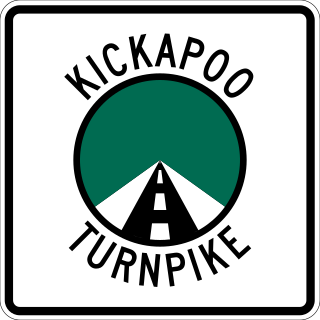
The Kickapoo Turnpike is a 19.6-mile (31.5 km) controlled-access toll road in the U.S. state of Oklahoma. The northern section from US-62 to I=44 opened to traffic on October 13, 2020. The southern segment from I-40 to US-62 opened to traffic on January 5, 2021.





















